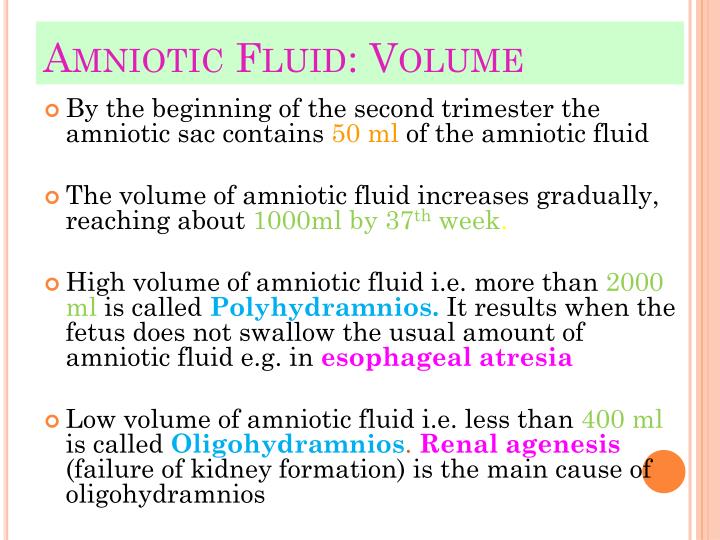

heart damage that can be short-term or permanent.Women who survive AFE can often have long-term complications, which can include: Older reports estimate that up to 80 percent of women don’t survive, although more recent data estimates that this number is about 40 percent. While results so far have been positive, further research is necessary to develop a better understanding of its applications in human trials.Per the AFE Foundation, estimated rates of mortality for women with AFE are varied. Promising research is being conducted to investigate how AFSCs can be used in regenerative medicine. Complications can also arise from bacterial infections. Complications concerning the amniotic sac, such as AFE, are not fully understood due to inconsistent reporting in nonfatal cases and inaccurate initial diagnoses. ConclusionĪmniotic fluid is produced to help an unborn baby grow its musculoskeletal system and protect the fetus from injury. A better understanding of AFSCs is necessary before research progresses to human trials. The promise of amniotic fluid in regenerative medicine lies in the cell’s inability to form tumors after in vivo implantation. Cardiac, kidney, and lung epithelial regeneration.

Some of the potential uses for AFSCs include: Research into amniotic fluid stem cells (AFSCs) has continued to increase in the field of regenerative medicine.

Meconium staining of amniotic fluid (dark green liquid passed by a newborn baby containing mucus, bile, and epithelial cells).Some of the risk factors for chorioamnionitis include: This condition can also present problems for the mother, including pelvic infection, sepsis, postpartum hemorrhage, and an increased risk of cesarean delivery. This condition is due to a bacterial infection in the fetal membranes, amniotic fluid, and placenta that has ascended from the vagina into the uterus.įor a newborn baby, chorioamnionitis can cause problems such as whole-body inflammation, sepsis, pneumonia, and meningitis. ChorioamnionitisĬhorioamnionitis, or intra-amniotic infection (IAI), is characterized by acute inflammation of the amnion and chorion. The risk of AFE reoccurrence is currently unknown. Maternal survival of AFE is uncommon however, successful pregnancies have been reported after pregnancies that have been complicated by AFE. Other reported risk factors for AFE include: There is a suggestion of increased incidence in women of a higher maternal age, which has been reported in at least two studies. No specific race or ethnicity is thought to be more susceptible to AFE, although one study has suggested a predilection in non-Hispanic black women. Some of the common symptoms of AFE include: It is currently estimated that AFE occurs in one case for every 8,000-30,000 pregnancies. The cause of AFE is not completely understood. Amniotic fluid embolismĪmniotic fluid embolism (AFE) is a sudden cardiorespiratory collapse and, thus, a medical emergency. Therefore, controlled clinical trials are required to definitively assess the clinical benefits and risks to both the mother and the baby for increasing liquid consumption to correct oligohydramnios. The amount of fluid can be increased by increasing liquid consumption however, the positive results of this treatment are not conclusive. There is a slightly increased risk of premature birth and problems with the baby’s position or the baby’s umbilical cord in causes of polyhydramnios. These symptoms are common problems for many pregnant women and do not always signify polyhydramnios. Polyhydramnios is a condition in which there is too much amniotic fluid surrounding the fetus. There are several complications that can occur concerning the amniotic sac, some of which include polyhydramnios, oligohydramnios, amniotic fluid embolism, and chorioamnionitis. The volume of amniotic fluid can also be used to predict adverse pregnancy outcomes however, this method’s predictive abilities are disputed. The need to repeat the test at a later dateīecause of these factors, an amniocentesis is carried out after 15 weeks of pregnancy, as the risk of complications is reduced after this point.There are some risks associated with an amniocentesis, including: This test involves taking a small number of cells from the amniotic fluid to test for these conditions. What is Amniotic Fluid Made Of? Play Medical uses for amniotic fluidĪ test called an amniocentesis is offered to some pregnant women if there is a higher chance that their baby might have a genetic condition such as Down’s syndrome, Edwards’ syndrome, or Patau’s syndrome.


 0 kommentar(er)
0 kommentar(er)
